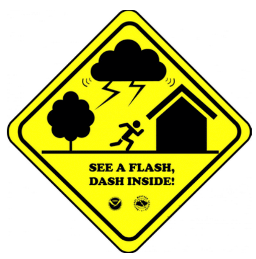Lightning

 Thunderstorms are always accompanied by lightning, but you can have lightning without a thunderstorm. Lightning occurs when the air becomes charged with electricity during a thunderstorm. Bolts of lightning travel at about 40,000 kilometres per second.
Thunderstorms are always accompanied by lightning, but you can have lightning without a thunderstorm. Lightning occurs when the air becomes charged with electricity during a thunderstorm. Bolts of lightning travel at about 40,000 kilometres per second.
What to do during
- If you can see lightning or hear thunder, you are in danger of being hit. Seek shelter immediately.
- Always take shelter during a lightning storm.
- There is no safe place outside during a thunderstorm. Safe shelter can be found either in an enclosed building or a hard-topped vehicle. Do not seek shelter under a tree or picnic area.
- Stay 15 feet away from other people so a lightning bolt cannot skip from one person to another.
- Stay away from bodies of water, including swimming pools.
- Wait 30 minutes after the last lightning strike in a severe storm before venturing outside again.
- Do not ride bicycles, motorcycles, tractors, or golf carts. These will not protect you from a lightning strike.
If lighting is close by, make yourself as small as possible by crouching down, keeping your head down and pulling your feet as close as you can to your body. Do not lie down; you want to make yourself as small as possible to give the lighting the smallest target you can. Keep your hands over your ears to protect your hearing.
Some info here: 5 striking facts versus myths about lightning you should know


 Thunderstorms are always accompanied by lightning, but you can have lightning without a thunderstorm. Lightning occurs when the air becomes charged with electricity during a thunderstorm. Bolts of lightning travel at about 40,000 kilometres per second.
Thunderstorms are always accompanied by lightning, but you can have lightning without a thunderstorm. Lightning occurs when the air becomes charged with electricity during a thunderstorm. Bolts of lightning travel at about 40,000 kilometres per second.